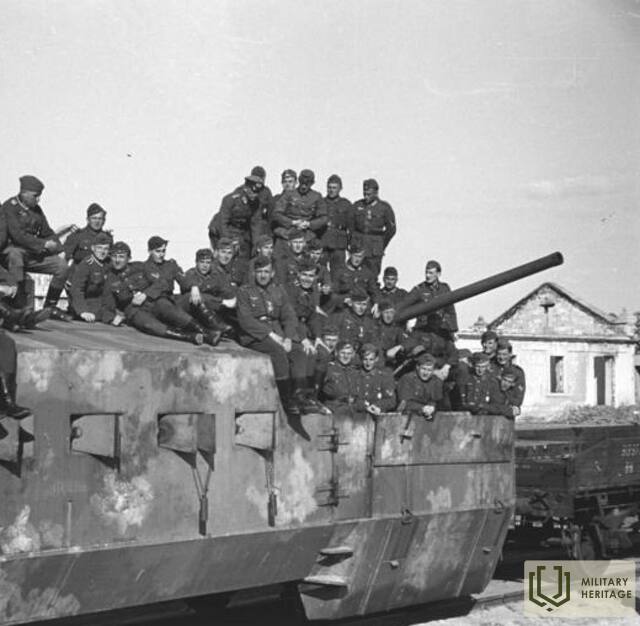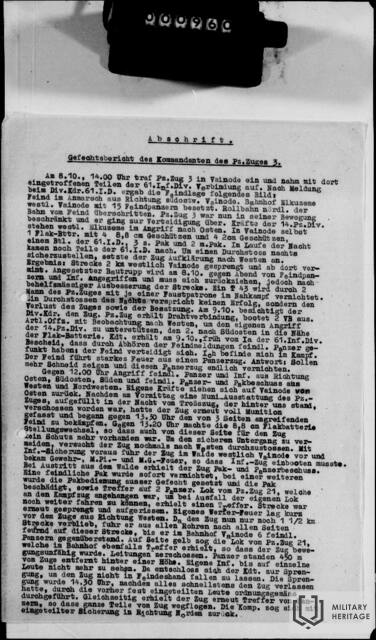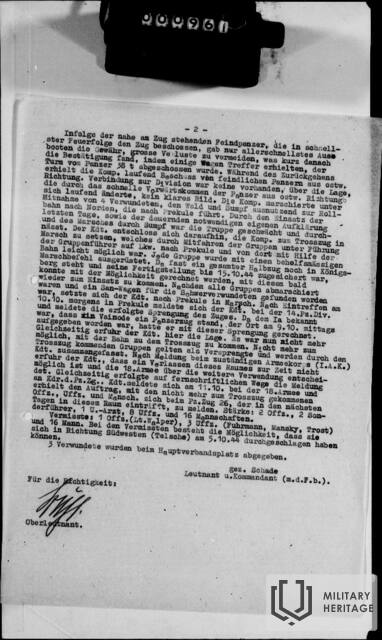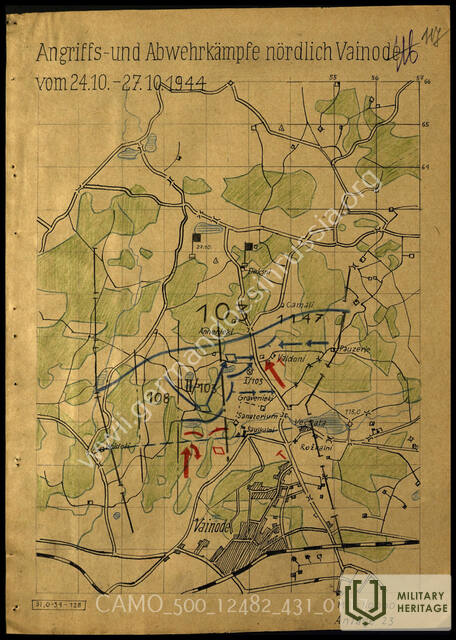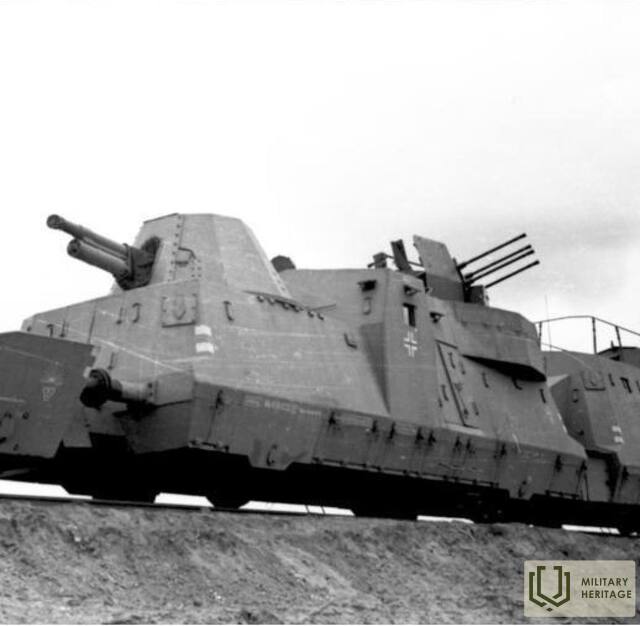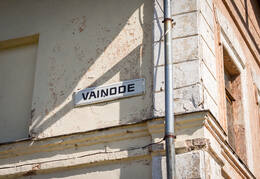Paskutinis Vokietijos armijos 3-iojo šarvuoto traukinio mūšis Vainodės stotyje
1944 m. spalį vokiečių armija traukiasi. Trečiasis šarvuotasis traukinys atvyksta į Vainodės stotį.
Žlugus vokiečių frontui, rytiniuose Vainodės pakraščiuose buvo tik nedideli vokiečių 61-osios pėstininkų divizijos daliniai, remiami šarvuoto traukinio. Pasipriešinimas buvo greitai įveiktas ir spalio 9 d. vakare visą Vainodę visiškai kontroliavo Raudonoji armija.
Vokietijos armijos šarvuoto traukinio Nr. 3 vado ataskaita atspindi įtemptus tų dienų įvykius ir šarvuoto traukinio Nr. 3 praradimą.
1944 m. spalio 8 d. šarvuotasis traukinys Nr. 3 atvyko į Vainodę ir užmezgė ryšį su taip pat atvykusiais 61-osios pėstininkų divizijos daliniais. Remiantis 61-osios pėstininkų divizijos štabo viršininko informacija, priešo pozicijos buvo tokios:
Priešas artėja prie Vainiodės iš pietryčių. Elkužemės stotį į vakarus nuo Vainiodės užėmė 15 priešo tankų. Priešas kirto greitkelį į šiaurę nuo stoties. Šarvuotas traukinys Nr. 3 dabar turėjo ribotas judėjimo galimybes, todėl užėmė gynybines pozicijas. 14-oji tankų divizija yra dislokuota vakarinėje Elkužemės dalyje ir ruošiasi pulti rytų kryptimi. Pačiame Vainiodėje yra viena baterija su keturiais 8,8 cm prieštankiniais ir priešlėktuviniais artilerijos pabūklais bei keturiais 2 cm pabūklais, vienas 61-osios pėstininkų divizijos batalionas, trys sunkieji ir du vidutinio galingumo prieštankiniai pabūklai. Naktį atvyko papildomi 61-osios pėstininkų divizijos daliniai. Traukinys pradėjo žvalgybą rajone į vakarus, kad naktį užtikrintų proveržį iš priešo apsupties vakarų kryptimi. Nustatyta, kad 2 km į vakarus nuo Vainiodės esantys bėgiai buvo susprogdinti ir iš ten užminuoti. Spalio 8 d. vakare priešo tankai ir pėstininkai puola statybų dalinį, kuris atsitraukia, tačiau kiek įmanoma užbaigia kai kuriuos bėgių kelio gerinimo darbus. Du šarvuoto traukinio įgulos nariai artimoje kovoje sunaikina vieną T34 tanką, naudodami prieštankinį granatsvaidį („Panzerfaust“). Naktinis bandymas prasiveržti atrodo nesėkmingas, dėl to žuvo šarvuotas traukinys ir jo įgula. Spalio 9 d. rytą divizijos vadas apžiūri traukinį. Į šarvuotą traukinį atitraukiami ryšio kabeliai, paskiriami du stebėtojai (2 VB). Vienas artilerijos karininkas, turintis stebėjimo pajėgumus, yra vakaruose, kad paremtų 14-osios tankų divizijos puolimą, antrasis – pietryčiuose, netoli baterijos. Ankstyvą spalio 9 d. rytą komendantas gauna pranešimą iš 61-osios pėstininkų divizijos štabo viršininko, kad perimtas priešo tankų radijo pranešimas: „Priešas ginasi. Aš mūšyje. Priešas atidengė ugnį iš šarvuoto traukinio. Atsakymas: parodykite didvyriškumą ir pagaliau sunaikinkite tą šarvuotą traukinį.“
Apie 12:00 val. iš rytų, pietryčių, pietų prasidėjo priešo tankų ir pėstininkų puolimas, o iš vakarų ir šiaurės vakarų – priešo tankų ir prieštankinių pabūklų ugnis. Mūsų kariuomenė traukiasi iš rytų atgal į Vainodį. Ryte apšaudžius vieną iš šarvuoto traukinio amunicijos sandėlių, kuris naktį buvo užpildytas iš tiekimo traukinio (Trosszug), stovėjusio tiesiai už šarvuoto traukinio, šarvuočio atsargos buvo visiškai atkurtos ir apie 13:30 val. jis pradėjo kovoti su priešu, puolančiu iš trijų pusių. Apie 13:20 val. baterija pakeitė savo poziciją taip, kad traukinys nebeturėjo priedangos iš tos pusės. Siekdamas išvengti neišvengiamo sunaikinimo, traukinys vėl bando prasiveržti į vakarus. Su pėstininkų daliniu priešakyje šarvuotasis traukinys įvažiavo į mišką į vakarus nuo Vainodės ir gavo šautuvų, kulkosvaidžių ir kulkosvaidžių ugnį, todėl pėstininkų dalinys turėjo atsitraukti. Palikęs miško priedangą, traukinį apšaudė prieštankiniai pabūklai ir tankai. Viena priešo patranka buvo nedelsiant sunaikinta, kita patrankos įgula buvo visiškai sunaikinta, patranka apgadinta, o du priešo tankai buvo pataikyti. Priešas taip pat pataikė į 21-ojo šarvuotojo traukinio lokomotyvą, kuris buvo prikabintas prie traukinio, jei tikrasis lokomotyvas būtų pažeistas. Bėgiai vėl buvo susprogdinti ir suplėšyti. Iš vakarų skriejusi minosvaidžio ugnis pataikė į traukinį labai arti. Kadangi traukiniui buvo likę tik 1,5 km bėgių, jis, šaudydamas iš visų įmanomų ginklų į visas puses, pajudėjo Vainodės stoties link, kur stotyje susidūrė su šešiais priešo tankais. 21-ojo šarvuotojo traukinio lokomotyvas stotyje taip pat gavo tiesioginį smūgį, todėl traukinys prarado galimybę judėti, nes jo techninės linijos buvo apšaudytos. Tankai buvo už 450 m už kalvos. Jo pėstininkų nebebuvo matyti, išskyrus kelis. Šiuo metu traukinio vadas priėmė sprendimą susprogdinti traukinį, kad jis nepatektų į priešo rankas. Kai iš traukinio buvo evakuota viskas, kas įmanoma, specialiai paskirti asmenys 14:30 val. įvykdė traukinio sprogdinimą. Tuo pačiu metu traukinį taip pat pataikė tankų sviediniai, todėl traukinio dalys išskrido į visas puses. Traukinio įgula atsitraukė į šiaurę.
Kadangi priešo tankai buvo arti ir nuolat apšaudė traukinį, vienintelė išeitis buvo kuo greičiau jį palikti, kad būtų išvengta didelių nuostolių. Tai patvirtino faktas, kad keli vagonai gavo tiesioginius pataikymus, o 38(t) tanko bokštelis buvo nuplėštas. Traukinio įgulai traukiantis, tankai iš rytų nuolat apšaudė. Su divizija nebuvo jokio ryšio ir nebuvo aišku apie nuolat kintančią situaciją. Įgula su keturiais sužeistais vyrais per pelkes ir miškus ėjo link plento šiaurėje, Priekulės link. Atsižvelgiant į pastarųjų dienų įvykius, nuolatinę žvalgybą ir atsitraukimą per pelkes, grupė buvo susilpnėjusi ir permirkusi. Vado tikslas buvo pristatyti savo įgulą į Priekulę ir spalio 15 d. palaukti pusės šarvuoto traukinio iš Karaliaučiaus, kad vėl galėtų su juo stoti į mūšį. Spalio 10 d. atvykęs į Priekulę, šarvuoto traukinio vadas praneša apie šarvuoto traukinio bombardavimą ir sužino, kad geležinkeliu nebeįmanoma pasiekti tiekimo traukinio ir neįmanoma palikti šios teritorijos. Spalio 11 d. komendantas gavo įsakymą iš Vokietijos 18-osios armijos vadovybės atvykti su personalu 26-uoju šarvuotuoju traukiniu. Sudėtis: 2 karininkai, 2 specialistai, 1 medikas, 8 instruktoriai ir 16 vyrų.
Dingę: 1 karininkas (leitenantas Walperis), 3 instruktoriai (Fuhrmannas, Manskis, Trostas) ir 16 vyrų. Gali būti, kad dingusieji spalio 5 d. pajudėjo į pietvakarius Telšių link. 3 sužeistieji buvo perkelti į pagrindinę tvarstymo stotį.
Pasirašė Schade – leitenantas ir vadas
NARA archyvai - Vokietijos armijos šarvuoto traukinio Nr. 3 vado ataskaitos stenograma (išversta iš vokiečių kalbos)
Susijusi laiko juosta
Susijusios vietos
Vainodės stotis
Geležinkelio stoties pastatas buvo atidarytas kartu su Liepojos–Vainodės geležinkelio linijos statyba 1871 m. Pats stoties pastatas buvo atidarytas 1872 m. Tai taip pat buvo didelės veiklos, plėtojant Vainodės centrines gatves, pradžia. Reikšminga tai, kad to meto vadovuose kiekvieno pastato ar objekto atstumas buvo nurodomas kaip atstumas nuo geležinkelio stoties. Geležinkelio stotis kadaise buvo svarbus karinis transporto mazgas.
Pirmojo pasaulinio karo metu nuo stoties iki aerodromo buvo nutiesta atšaka, kuria buvo atgabenamos medžiagos (metalinės formos angarams), kranai, gervės ir amunicija karo atsargoms, kurios vėliau cepelinais buvo gabenamos į Rygą ir bombarduojamos rusų įtvirtinimai.
Geležinkelio stoties pastatas nebuvo nuniokotas Antrojo pasaulinio karo ir laikui bėgant nepakito savo išvaizdos. Vainodės stotį galima pamatyti iš išorės.
Karinė veikla Vainodės apylinkėse siejama su sėkmingu Raudonosios armijos puolimu, prasidėjusiu 1944 m. spalio 5 d. Šiaulių apylinkėse. Greitai sutriuškinę silpną vokiečių pasipriešinimą, sovietų tankų daliniams buvo pavesta užimti strategiškai svarbią Liepojos–Šaulio geležinkelio liniją. 1944 m. spalio 9 d. ankstyvą rytą puolimą pradėjo pirmieji 19-ojo tankų korpuso 79-osios tankų brigados daliniai ir atskiri 143-osios tankų brigados daliniai. Žlugus vokiečių frontui, rytiniame Vainodės pakraštyje buvo tik nedideli vokiečių 61-osios pėstininkų divizijos daliniai, remiami šarvuočių. Pasipriešinimas buvo greitai įveiktas ir spalio 9 d. vakare visą Vainodę visiškai kontroliavo Raudonoji armija. Spalio 10 d. atvyko sovietų 6-osios gvardijos armijos 103-ojo šaulių korpuso daliniai ir tęsė atakas, atstumdami vokiečių 61-ąją pėstininkų diviziją 2 km į šiaurę nuo Skaistkalnės sanatorijos. Sovietų pajėgoms užimant Vainodę be didelių kovų, Vainodės stotis ir miesto pastatai nukentėjo palyginti mažai.
1944 m. spalio 24 d. kovos šiek tiek priartėjo prie Vainodės, kai vokiečių 10-asis korpusas, vadovaujamas 14-osios tankų divizijos, įvykdė puolimo operaciją, pravarde „Eberhardas“. Kovų metu fronto linija sutelkė jėgas į šiaurę nuo sanatorijos ir ten išsilaikė iki spalio 27 d., kai Raudonoji armija pradėjo puolimą, vadinamą 1-uoju Kurlando bolševiku.




